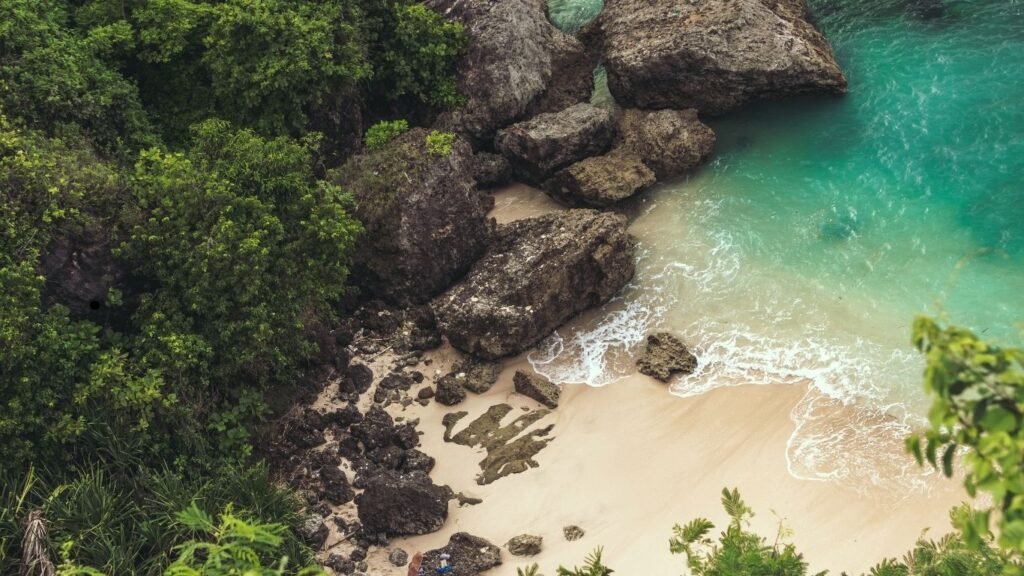South Sentinel Island is a remote gem tucked away in the Andaman Sea, part of India’s Andaman and Nicobar Islands. This uninhabited island, with its untouched landscapes and pristine ecosystems, has remained largely isolated from human interference. Spanning only 1.61 square kilometers, South Sentinel Island is home to a vast range of natural wonders. It offers a sanctuary for various species, preserving its biodiversity and unique habitat that has not been affected by human hands. The island stands as a testament to nature’s resilience and beauty, an undiscovered paradise that showcases the earth’s raw ecological splendor.
Geography and Features of South Sentinel Island
South Sentinel Island is blessed with a variety of geographical features that make it a captivating destination for those interested in nature. With dense tropical forests, unique mangroves, and stunning coral reefs surrounding it, this island is a haven for wildlife and marine life alike. The highest point on the island rises 44 meters above sea level, offering panoramic views of the surrounding ocean. The diverse ecosystems found on South Sentinel Island contribute to the island’s overall importance as a protected area.
Below is a table summarizing the geographical features of South Sentinel Island:
| Feature | Description |
| Location | Andaman Sea, part of the Andaman and Nicobar Islands, India |
| Area | 1.61 square kilometers |
| Elevation | Highest point is 44 meters above sea level |
| Topography | Dense tropical forests, mangroves, and coral reefs |
| Coral Reefs | Surround the island, providing shelter to marine life |
| Surrounding Water | Turquoise blue water with rich marine biodiversity |
| Climate | Tropical rainforest climate with high humidity and rainfall |
| Vegetation | Tropical evergreen forests, mangroves, and littoral forests |
| Biodiversity | Rich in endemic species, including coconut crabs, geckos, and birds |
| Accessibility | Limited access, protected by the Restricted Area Permit (RAP) |
The coral reefs around the island are crucial to maintaining its natural balance. These reefs create a safe haven for marine life, preventing coastal erosion and maintaining the health of the waters. The beauty and ecological diversity of South Sentinel Island remain largely untouched by human activity, ensuring that the island remains a sanctuary for biodiversity.
The abundant flora and fauna of South Sentinel Island

One of the most intriguing aspects of South Sentinel Island is its incredible diversity of flora and fauna. While the island itself remains uninhabited, it is home to a variety of species, many of which are endemic to the region. These species have evolved in isolation, allowing them to thrive in a pristine, unspoiled environment.
The island’s tropical forests are rich in wildlife, including coconut crabs, which roam freely along the beaches, and the Andaman day geckos, endemic to this region. Bird watchers will find the island a paradise, with species like the pied imperial pigeon and the Nicobar pigeon calling the island home. These birds play a crucial role in the island’s ecosystem by assisting in seed dispersal, thus helping maintain the region’s plant life.
The surrounding coral reefs are equally vibrant, offering refuge to various marine creatures. These reefs are essential for the health of the surrounding waters, providing a habitat for fish, turtles, and various other marine species. The isolation of South Sentinel Island has helped preserve these ecosystems, making it a prime example of how nature can thrive when left undisturbed.
Legal Safeguards and Conservation of South Sentinel Island
To protect its delicate ecosystems, South Sentinel Island has been designated a wildlife sanctuary by the Indian government. Strict regulations govern access to the island, ensuring that it remains a safe and secure environment for the many species that inhabit it. The island’s status as part of the Restricted Area Permit (RAP) regime means that only authorized personnel, such as researchers and conservationists, are allowed to visit, and even then, with prior approval.
This controlled access is crucial for maintaining the island’s ecological integrity. By limiting human activity, the government has been able to preserve the natural beauty of South Sentinel Island, preventing the over-exploitation of its resources and protecting the habitat of its unique wildlife. These measures help ensure that the biodiversity of the island remains intact, and that its ecosystems continue to thrive without interference.
Importance of South Sentinel Island for Marine and Terrestrial Conservation
South Sentinel Island plays a key role in both marine and terrestrial conservation. The island’s coral reefs act as vital barriers to coastal erosion, while also supporting a wide range of marine species. These reefs contribute to the overall health of the marine environment in the Andaman Sea, providing shelter and sustenance for fish and other marine creatures.
On land, the forests of South Sentinel Island provide shelter to a variety of endemic species. The island’s flora, including its tropical trees and plants, sustains wildlife and helps maintain the ecological balance of the region. By protecting South Sentinel Island, conservationists are not only preserving the island itself but also contributing to the health of the wider Andaman and Nicobar Islands ecosystem.
The unique ecosystems found on South Sentinel Island are crucial for maintaining the balance of the region’s biodiversity. Both the land and marine environments on the island play important roles in sustaining the health of the Andaman Sea. The preservation of these ecosystems is vital for the long-term health of the region and serves as an example of how ecosystems can thrive when left undisturbed.
The Cultural Significance of South Sentinel Island
While South Sentinel Island is largely devoid of human habitation, it is connected to the broader cultural heritage of the Andaman and Nicobar Islands. The island’s proximity to North Sentinel Island, home to the isolated Sentinelese people, gives it a unique cultural significance. The Sentinelese are known for their deep-seated isolation, and their way of life has remained untouched for centuries. While there are no known interactions between the Sentinelese and the inhabitants of South Sentinel Island, the island is still part of the larger cultural and historical context of the Andaman Islands.
For those interested in anthropology, the Sentinelese offer a fascinating glimpse into an ancient culture. Their isolation has allowed them to preserve their traditions and way of life, making the Andaman Islands, including South Sentinel Island, an area of cultural and anthropological interest. As researchers continue to study the region, South Sentinel Island plays an important role in understanding how humans have interacted with nature over the centuries.
Must Read : Cities in Turkey Country: Top Must-See Destinations Await
The Future of Ecotourism on South Sentinel Island
Although South Sentinel Island is currently closed to tourists, the island holds immense potential for future sustainable ecotourism, should regulations change. Its natural beauty, rich biodiversity, and unique ecosystems make it a potentially attractive destination for eco-conscious travelers seeking to experience nature in its purest form. However, any future ecotourism development would need to be carefully managed to ensure that the island’s fragile ecosystems are not disturbed.
Ecotourism could provide an opportunity to raise awareness about the importance of conservation and the need to protect such pristine environments. By promoting sustainable travel, ecotourism could help fund conservation efforts and support the protection of South Sentinel Island. Responsible tourism could also educate visitors on the importance of preserving untouched ecosystems and help foster a greater appreciation for the natural world.
The Contribution of South Sentinel Island to Global Conservation Initiatives
South Sentinel Island is a critical piece of the global conservation puzzle. As the world faces growing environmental challenges such as climate change and habitat loss, the need to protect areas like South Sentinel Island becomes more urgent. The island serves as a natural laboratory for studying biodiversity, ecosystems, and the impacts of climate change in isolated environments. By protecting South Sentinel Island, we are preserving a key component of the planet’s ecological heritage.
Conservationists and researchers around the world recognize the importance of areas like South Sentinel Island, and their work is crucial for understanding how ecosystems function in their natural state. The preservation of such areas contributes to global efforts to protect biodiversity and mitigate the effects of environmental degradation.
Conclusion
South Sentinel Island is a remarkable and pristine environment, offering a rare glimpse into a world that remains largely untouched by human influence. Its diverse ecosystems, from its tropical forests to its vibrant coral reefs, make it a critical area for conservation and research. While access to the island is limited, its importance in maintaining the biodiversity of the Andaman and Nicobar Islands cannot be overstated. As we look to the future, it is essential that South Sentinel Island and similar areas are protected and preserved, ensuring that they remain hidden paradises of nature and life for generations to come.
By prioritizing conservation and sustainable practices, we can safeguard South Sentinel Island and continue to learn from its untouched ecosystems, all while fostering greater global awareness about the importance of protecting our planet’s natural wonders.
Thanks for visiting budgethackscwbiancamarket.com. Don’t forget to share it on Twitter.

